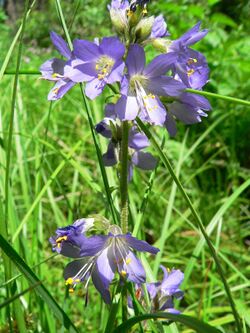Biology:Polemonium occidentale
| Polemonium occidentale | |
|---|---|

| |
| Scientific classification | |
| Kingdom: | Plantae |
| Clade: | Tracheophytes |
| Clade: | Angiosperms |
| Clade: | Eudicots |
| Clade: | Asterids |
| Order: | Ericales |
| Family: | Polemoniaceae |
| Genus: | Polemonium |
| Species: | P. occidentale
|
| Binomial name | |
| Polemonium occidentale Greene
| |
Polemonium occidentale is a species of flowering plant in the phlox family known by the common names western polemonium[1] and western Jacob's-ladder. There are two subspecies.[2] The common ssp. occidentale is native to western North America from British Columbia to Colorado to California , where it can be found in moist areas of many habitat types, including meadows and woodlands. There is also a rare subspecies, ssp. lacustre, which is known only from a total of three counties in Minnesota and Wisconsin, and is found only in white cedar swamp habitat there.[2]
This is a rhizomatous perennial herb producing an erect stem up to one meter tall. The leaves are located along the stem, each divided into many small lance-shaped leaflets. The inflorescence is an open, elongated array of several bell-shaped, five-lobed flowers each up to 1.5 centimeters long. The flower corolla is blue to bright purple with a white throat.[3]
The rare subsp. lacustre faces threats including peat mining in its swamp habitat, herbivory by deer, and alterations in the local hydrology where it grows.[2] There are only five populations of this subspecies.[4]
References
- ↑ "Polemonium occidentale". Natural Resources Conservation Service PLANTS Database. USDA. https://plants.usda.gov/core/profile?symbol=POOC2. Retrieved 9 October 2015.
- ↑ 2.0 2.1 2.2 Schmidt, L. J. Conservation Assessment for Polemonium occidentale v. lacustre, Western Jacob's Ladder. USFS. September 2003.
- ↑ "Western Sky Pilot, Polemonium occidentale". https://calscape.org/Polemonium-occidentale-().
- ↑ Center for Plant Conservation
External links
Wikidata ☰ Q7209292 entry
 |

